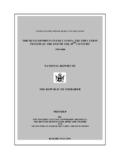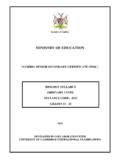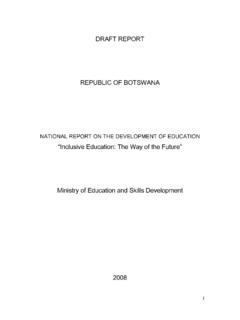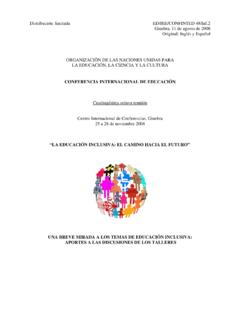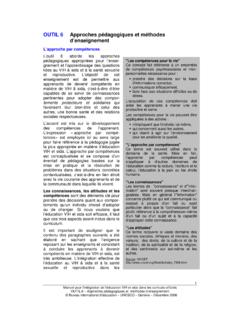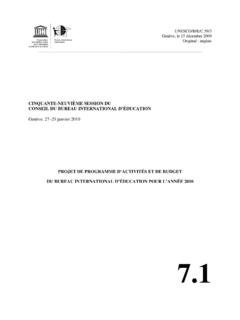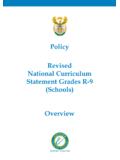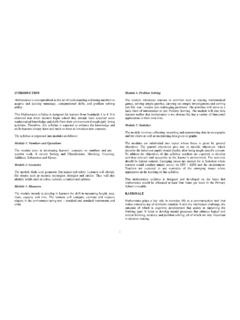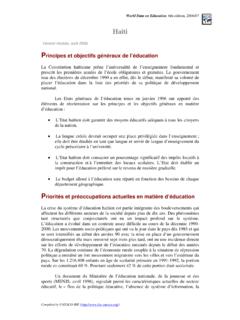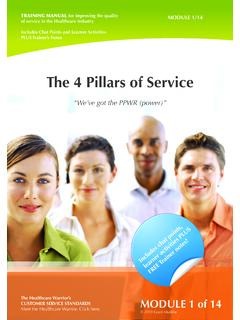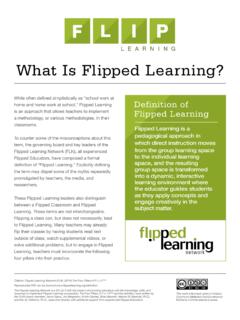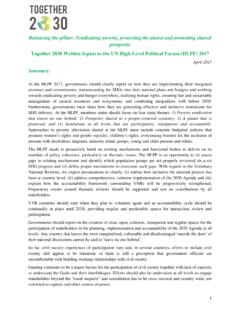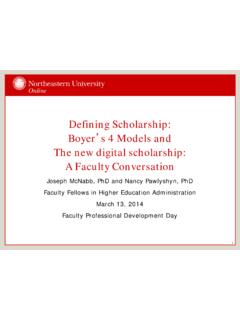Transcription of Four ‘Pillars of Learning’ for the Reorientation and ...
1 four pillars of Learning for the Reorientation and Reorganization of Curriculum: Reflections and Discussions Zhou Nan-Zhao* Introduction In achieving the goals of quality education for all (EFA) there is a great need to develop a broadened vision of educational goals, to facilitate holistic approaches to reorganizing educational contents, and to build national capacity in developing key competencies required of all learners through curriculum renewal in emerging knowledge-based societies of the 21st century. In an information-intensive age, education is mandated to respond to demands in two directions: on the one hand, it has to transmit an increasing amount of constantly evolving knowledge and know-how adapted to a knowledge-driven civilization; on the other hand, it has to enable learners not to be overwhelmed by the flows of information, while keeping personal and social development as its end in view.
2 Therefore education must ..simultaneously provide maps of a complex world in constant turmoil and the compass that will enable people to find their way in it . (Delors et al, p85). Curriculum change has become increasingly important, inasmuch as it is essential that what students learn is relevant to them as individuals and members of society, in their present and future contexts. It lies at the center of educational processes in enabling learners to become not only successful learning achievers at school but also responsible citizens, effective workers, caring community members, and life-long learners, in an increasingly interdependent world. This paper is intended to reflect on the four pillars of learning, as proposed by the International Commission for the Twenty-first Century, in its Report (Delors et al) to UNESCO, Learning: The Treasure Within, and to discuss their implications for curricular change both as guiding principles for and cross-cutting themes.
3 A central argument is that if education is to succeed in its tasks, curriculum as its core should be restructured or repacked around the four pillars of learning: learning to know, learning to do, learning to live together, and learning to be. Redefining Curriculum and Curriculum Change Curriculum is a critical factor affecting educational quality and learning achievement. Numerous research studies have shed light on main factors affecting or accounting for learning achievements, or quality of education. In an input-process-outcomes framework, curriculum content and textbooks and learning materials are among the major school inputs. They are also a major dimension of quality education (UNESCO, 2004). The concern to renew curriculum has been at the heart of the world-wide efforts in improving quality of education for all. There are varied definitions of curriculum . For one, curriculum may mean the way educational content is organized and presented in classroom and after-school activities to meet different learning needs.
4 In changing educational and development contexts, curriculum is no longer merely a conveyor or product of a particular body of knowledge but a dynamic process of actual learning acquisition and inquiry of the unknown through teacher-learner interaction and cooperation . From a pragmatic viewpoint, curriculum could be seen as both process and product, comprising all learning and other experiences that the school or education system plans for its learners. As education influences and reflects the values of society it is necessary to recognize a broad set of common values and purposes that underpin curriculum. It is important to take note of the changing nature of curriculum development as an ongoing process aimed at organizing better learning opportunities and thus focuses on actual interactions between the teacher and the learner (IBE, 1999). It implies continuing efforts in translating educational goals into appropriately designed learning materials, activities and observable behavioral changes.
5 Varied curriculum development models have been applied for fundamental reorganization or repackaging of curriculum content and delivery method. Curriculum change in this Resource Pak is defined as a dynamic process involving many stakeholders and responding to diversified learning needs as well as social demands Using the four pillars of learning as fundamental principles and cross-cutting themes is intended to be an alternative approach to the facilitation of curriculum change through resetting objectives, identifying/selecting key competencies, and integration of relevant knowledge, skills and values across curriculum areas or learning domains. Revisiting the four pillars of Learning In order that the essence of the four pillars of learning be appropriately interpreted, a brief snapshot follows of what each relates to in term of educational context. Learning to know This type of learning is radically different from acquiring itemized codified information or factual knowledge , as often stressed in conventional curriculum and in rote learning.
6 Rather it implies the mastering of the instruments of knowledge themselves . Acquiring knowledge in a never-ending process and can be enriched by all forms of experience . Learning to know includes the development of the faculties of memory, imagination, reasoning, problem-solving, and the ability to think in a coherent and critical way. It is a process of discovery , which takes time and involves going more deeply into the information/knowledge delivered through subject teaching. Learning to know presupposes learning to learn , calling upon the power of concentration, memory and thought , so as to benefit from ongoing educational opportunities continuously arising (formally and non-formally) throughout life. Therefore learning to know can be regarded as both a means and an end in learning itself and in life. As a means, it serves to enable individual learners to understand the very least enough about the nature, about humankind and its history, about his/her environment, and about society at large.
7 As an end, it enables the learner to experience the pleasure of knowing, discovering and understanding as a process. Learning to do This pillar of learning implies in the first place for application of what learners have learned or known into practices; it is closely linked to vocational-technical education and work skills training. However it goes beyond narrowly defined skills development for doing specific things or practical tasks in traditional or industrial economies. The emerging knowledge-based economy is making human work increasingly immaterial. Learning to do calls for new types of skills, more behavioral than intellectual. The material and the technology are becoming secondary to human qualities and interpersonal relationship. Learning to do thus implies a shift from skill to competence, or a mix of higher-order skills specific to each individual. The ascendancy of knowledge and information as factors of production systems is making the idea of occupational skills obsolete and is bringing personal competency to the fore.
8 Thus learning to do means, among other things, ability to communicate effectively with others; aptitude toward team work; social skills in building meaningful interpersonal relations; adaptability to change in the world of work and in social life; competency in transforming knowledge into innovations and job-creation; and a readiness to take risks and resolve or manage conflicts. Learning to live together In the context of increasing globalization, the Delors Commission places a special emphasis on this pillar of learning. It implies an education taking two complementary paths: on one level, discovery of others and on another, experience of shared purposes throughout life. Specifically it implies the development of such qualities as: knowledge and understanding of self and others; appreciation of the diversity of the human race and an awareness of the similarities between, and the interdependence of, all humans; empathy and cooperative social behavior in caring and sharing; respect of other people and their cultures and value systems; capability of encountering others and resolving conflicts through dialogue; and competency in working towards common objectives.
9 Learning to be This type of learning was first conceptualized in the Report to UNESCO in 1972, Learning To Be (Edgar Faure et al), out of the fear that the world would be dehumanized as a result of technical change . It was based on the principle that the aim of development is the complete fulfillment of man, in all the richness of his personality, the complexity of his forms of expression and his various commitments as individual, member of a family and of a community, citizen and producer, inventor of techniques and creative dreamer . Learning to be may therefore be interpreted in one way as learning to be human, through acquisition of knowledge, skills and values conducive to personality development in its intellectual, moral, cultural and physical dimensions. This implies a curriculum aiming at cultivating qualities of imagination and creativity; acquiring universally shared human values; developing aspe!
10 Cts of a person s potential: memory, reasoning, aesthetic sense, physical capacity and communication/social skills; developing critical thinking and exercising independent judgment; and developing personal commitment and responsibility. It is important to note that the four pillars of learning relate to all phases and areas of education. They support and interpenetrate one another and should therefore be applied as basic principles, cross-cutting themes and generic competences for integration in and across subject areas or learning domains. pillars of Learning for Reorienting Curriculum Objectives Generally speaking, school curriculum seeks to achieve two broad aims: one to provide equal opportunities for all pupils to learn and to achieve, for best possible progress and at the highest attainment. The other is to promote learners spiritual, moral, social and cultural development and prepare all pupils for the world of work and societal responsibilities.
